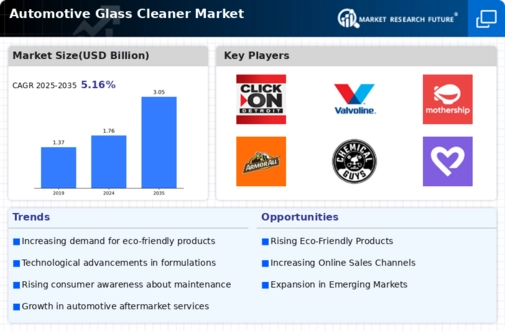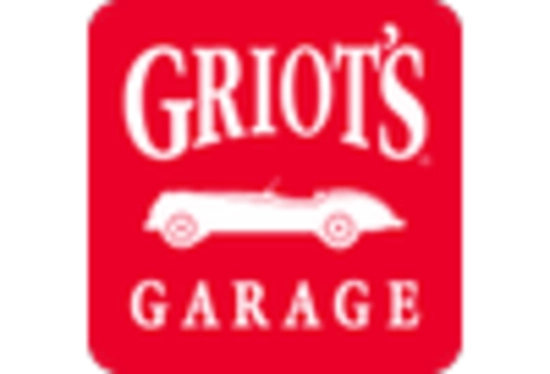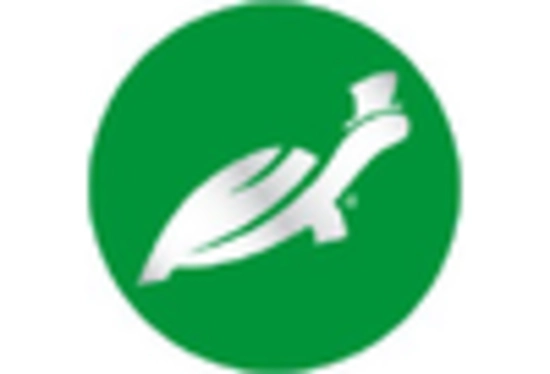Rising Vehicle Ownership
The increasing rate of vehicle ownership is a pivotal driver for the Automotive Glass Cleaner Market. As more individuals acquire vehicles, the demand for maintenance products, including glass cleaners, escalates. In recent years, the number of registered vehicles has surged, leading to a heightened focus on vehicle upkeep. This trend is particularly pronounced in emerging markets, where economic growth correlates with rising disposable incomes. Consequently, consumers are more inclined to invest in quality automotive care products. The Automotive Glass Cleaner Market is likely to benefit from this trend, as vehicle owners seek effective solutions to maintain visibility and safety. Furthermore, the growing awareness of the importance of vehicle maintenance is expected to further bolster the demand for automotive glass cleaners.
Technological Advancements
Technological innovations in the formulation and application of automotive glass cleaners are significantly influencing the Automotive Glass Cleaner Market. Manufacturers are increasingly developing advanced cleaning solutions that offer superior performance, such as streak-free finishes and enhanced dirt-repelling properties. These innovations not only improve the efficacy of glass cleaners but also cater to the evolving preferences of consumers who seek convenience and effectiveness. Moreover, the integration of eco-friendly ingredients in formulations aligns with the rising consumer demand for sustainable products. As a result, the Automotive Glass Cleaner Market is witnessing a shift towards products that combine performance with environmental responsibility. This trend is expected to drive growth as consumers become more discerning about the products they choose for their vehicles.
Expansion of Retail Channels
The expansion of retail channels is playing a vital role in shaping the Automotive Glass Cleaner Market. With the proliferation of e-commerce platforms and the enhancement of traditional retail outlets, consumers now have greater access to a variety of automotive care products, including glass cleaners. This increased availability is likely to stimulate demand, as consumers can easily compare products and make informed purchasing decisions. Furthermore, the rise of specialty automotive stores and online marketplaces provides consumers with a wider selection of brands and formulations. As a result, the Automotive Glass Cleaner Market is poised for growth, driven by the convenience and accessibility of these retail channels. This trend may also encourage manufacturers to innovate and diversify their product offerings to meet the evolving preferences of consumers.
Increased Awareness of Vehicle Safety
The growing awareness of vehicle safety is a crucial driver for the Automotive Glass Cleaner Market. As consumers become more informed about the importance of clear visibility for safe driving, the demand for effective glass cleaning solutions rises. Studies indicate that a significant percentage of accidents are attributed to poor visibility, which underscores the necessity of maintaining clean windshields and windows. This awareness is prompting vehicle owners to prioritize the use of quality automotive glass cleaners. Consequently, the Automotive Glass Cleaner Market is likely to experience growth as consumers actively seek products that enhance their driving safety. Additionally, educational campaigns by automotive organizations further emphasize the importance of regular maintenance, thereby reinforcing the demand for glass cleaning products.
Environmental Regulations and Sustainability
The implementation of stringent environmental regulations is increasingly influencing the Automotive Glass Cleaner Market. Governments worldwide are enacting policies aimed at reducing the environmental impact of automotive products, including cleaning solutions. This regulatory landscape is prompting manufacturers to develop eco-friendly formulations that comply with these standards. As consumers become more environmentally conscious, there is a growing preference for sustainable products that minimize harm to the environment. Consequently, the Automotive Glass Cleaner Market is likely to see a shift towards biodegradable and non-toxic cleaning solutions. This trend not only aligns with regulatory requirements but also caters to the evolving consumer demand for responsible products. Manufacturers that prioritize sustainability may gain a competitive edge in this dynamic market.

















Leave a Comment